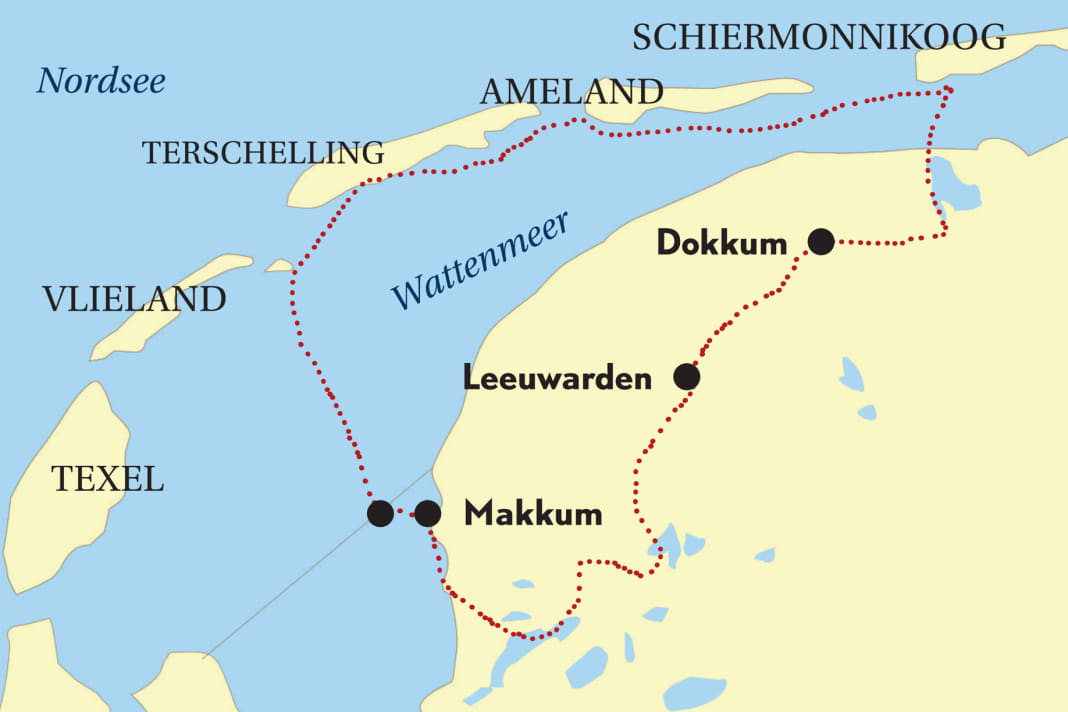





"Thank you for your message, which I can't answer at the moment as I'm on an extended sailing trip. I'll get back to you when I return!" Who wouldn't want to leave this or a similar message on their voicemail, switch off the computer and go sailing?
Every year, countless sailors demonstrate how it works to swap a job and career for the cockpit and chart table for a while. Antje and Ingo Paulus, for example, sailed around the North Atlantic for 14 months during their sabbatical and worked up an appetite for an even bigger trip (YACHT 13/2022). Alexander Arnold and Mandy Entken worked in a company where sabbaticals are the norm and used their time on board to try their hand at sailing vlogging (YACHT 13/2021).
Quite a few working people go on a longer cruise to gather inspiration for something new, perhaps even to reorient themselves professionally. For Matthias and Luisa Werb, however, their two-year break from work was purely a sailing adventure. "We weren't on a self-discovery trip. It was a journey of exploration and adventure," says Matthias Werb, looking back on the couple's circumnavigation. Ebru Yaral from Hamburg also shows what is possible: thanks to her employer's sabbatical model, the 43-year-old is currently sailing around the world as part of an international crew in the Ocean Globe Race. She even has Cape Horn in her wake.
Which time-out model is the right one?
But is the much-cited "just do it" really that simple? What should you bear in mind if you are planning a sailing holiday lasting several months or years and there is so much more to do beforehand than before the annual summer cruise?
Assuming that the crew can sail and owns a boat, the first question is the time-out model. How much time should be available for the big trip - and where will it come from? Students and new parents have it relatively easy. They can use the time between graduation and their first job or their parental leave. Self-employed people can try to fit work around the time off or get a replacement in the company, as the example of Uwe and Anke Müntz shows (see book tip "Blaugemacht".
However, employees should clarify with their boss well in advance how the longer absence can be realised - whether via a working time account, a part-time model or unpaid leave. The last resort is to resign or take time off between the old and new job if a change is planned anyway. Author Andrea Oder explains the various models in her book "Sabbatical - Realise your dream of taking a temporary break" and gives examples from business and the public sector. She also addresses the question of when it is best to start the project. "Plan as much time for preparation as you want your sabbatical to last and then double this time," she advises. "Experience has shown that it takes this long from the idea to realisation. So for a six-month sabbatical, you should allow around twelve months for preparation."
Determining the route for the sabbatical
However, the planning time required is usually very individual and depends, among other things, on how you organise your time away: If your own home is sublet furnished, this item on the to-do list can be ticked off more quickly than if everything is cleared out and put into storage. And of course, the preparation time depends very much on the condition of the boat.
Two main factors determine how long the time out should - or can - last: Which route is on the itinerary and how long does it take? And what does the ship's budget allow? A sailing sabbatical is the perfect opportunity to realise a trip you've been dreaming of for a long time - whether it's to Brittany and back or a trip around the Baltic Sea. The possibilities and variations are manifold.
Despite all the euphoria, you shouldn't plan the route too ambitiously and, above all, decide what purpose the sailing holiday should fulfil. Is it about making miles and getting to know new people and cultures, like Matthias and Luisa Werb? Or is the focus on slowing down, unwinding and watching the sun go down for days at an anchorage? You should also weigh up whether it is a good idea to receive visitors at predetermined places and dates on board or whether fixed appointments on the way are not rather stressful. "It doesn't matter whether you have a year at your disposal or less. You can never fit all your wishes and goals into a sabbatical," writes sabbatical coach Andrea Oder on the subject of making plans. "For a sabbatical, the saying applies in particular: less is usually more."
Adapt the route to reality
You should therefore also consider in advance what travelling pace can be maintained. How many miles can the crew cover per day or week over a longer period of time? Delays due to repairs or bad weather must always be taken into account. An average of 25 miles per day doesn't sound like much at first. But after just two nights in the same place, 50 nautical miles are expected the following day, and 75 nautical miles for three nights.
Of course, it is also possible to set off without a fixed plan. This is also exciting and tempting. However, you rob yourself of the anticipation that arises when you dream yourself into the planned sailing area while looking at sailing guides and nautical charts before setting off. What is certain is that a three-month sailing sabbatical between Kiel and Copenhagen can be just as enjoyable as a whole circumnavigation. After all, whatever you like is allowed - and whatever you can afford on board! But what does the fun cost?
Financial considerations
Long-distance sailors travelling the world usually calculate with around 1,500 to 2,500 euros per month. The only upper limit is your own. Thrifty crews get by with less. As on land, life on board is a question of the standard of living you are used to, your own wishes and ideas. Do I want to lie in the harbour every evening, eat out and do everything the destination has to offer on land? Or is one harbour every few days enough, otherwise I will anchor? Does the crew cook for themselves and only take advantage of cheap sightseeing offers? These three measures alone can quickly save you 1,000 euros or more per month. All of this certainly depends heavily on the area and the possibilities there.
What can be precisely calculated in advance are the monthly fixed costs: health insurance, boat insurance and other private insurances are usually a large item. One way to top up the travel budget is to buy a house or flat back home: if your own home is simply empty, the costs continue to run. If you give notice or sublet, you save hundreds of euros per month - but the costs of subletting or moving out increase.
Like route and financial planning, many other aspects of preparation are very individual. The following checklist provides general tips. Some useful instructions can also be found on the Trans-Ocean website in the "Wanderlust" section under the keyword "Lossegler tips". It is also important to talk to old hands who have already dared to experiment. This will help you not to get bogged down, not to become too perfectionist and still plan systematically. After all, the preparation is part of the adventure and should be enjoyed!
So when will it finally start? Finding the perfect time for a sailing sabbatical is certainly not easy. But perhaps it is wise to proceed in the same way as with reefing - and start preparing as soon as you think about it for the first time.
Ready to go? The checklist
Communication, data
- Clarify how to get Internet on board (Wi-Fi aerial? Mobile router with SIM cards? Smartphone as hotspot?)
- If necessary, prepare a travel blog/Youtube channel or similar
- Prepare data backup for travel photos
- Install translation app on mobile phone/tablet
Special equipment
- New logbook
- At least one credit card, cash
- Boat papers (proof of insurance/ownership; driving licence)
- Guest country flags
- Gifts for guests
- Equipment and spare parts that are difficult to obtain while travelling
- Area guide and nautical charts for the route
House, flat, car
- What happens to the house or flat? Find a subtenant or give notice; if the home remains empty, clarify who is looking after it
- In the event of house clearance: change or deregister address, provide new postal address
- Who opens the post? Place a forwarding order
- If possible, switch to electronic correspondence, e.g. insurance companies are increasingly offering this service
- Take the opportunity to sort out; sell unnecessary possessions
- Sell or deregister car if necessary
Papers and authorities
- Digitise and back up travel documents and important papers
- Check whether cards (bank, health insurance, etc.) expire during the trip; extend if necessary
- Make a tax return or extend the deadline
- Activate the digital function of the ID card
- Apply for an international driving licence and visa if necessary
- Cancel subscriptions (e.g. gym, streaming services, sports club)
- Cancel contracts that are no longer required (e.g. for household contents or car)
Health
- Bring the on-board pharmacy up to date
- Refresh your first aid skills
- Check-up appointment with family doctor and dentist
- Check immunisation, complete travel vaccinations
- If necessary, obtain replacement glasses and sufficient medication and contact lenses for the journey
Insurance and finance
- Take out travel health insurance abroad
- Pack a credit card, apply for one if necessary
- If necessary, extend the sailing area of the boat insurance
- Update, issue or delete standing orders, bank authorisations, etc.
From S to XXL: ideas for the itinerary






Meadows and Wadden Sea: sailing through Holland
- Route: Inland through Friesland, across the IJsselmeer and, with sufficient experience, out to the islands: The area is diverse!
- Duration: Anything from a week to a season is conceivable.
- Suitable for: Families with children, North Sea fans and anyone who wants to visit the water sports-loving neighbouring country.
Summer dream: Baltic Sea tour
- Route: Along the Baltic and Scandinavian coasts around the Baltic Sea and Gulf of Bothnia.
- Duration: About one season. Even longer with winter storage en route.
- Suitable for: Sailors who want to discover many different countries in a short space of time and enjoy travelling.
Colourful mix: around Europe
- Route: Take the boat piggyback to the Mediterranean, sail back from there along Europe's coasts - or vice versa.
- Duration: At least two seasons should be available.
- Suitable for: Experienced sailors or owner groups with different preferences for the Mediterranean, Atlantic and North Sea.
From soft to hard: around the North Sea and England
- Route: Around England, Wales and Scotland; optionally as part of a North Sea tour with detours to Norway.
- Duration: If you have the time, it's best to use the whole summer.
- Suitable for: Experienced sailors with seaworthy boats who are familiar with navigating in tidal areas.
Ocean adventure: North Atlantic tour
- Route: From the North Sea, Baltic Sea or Mediterranean to the Canary and Cape Verde Islands, across the Atlantic and back.
- Duration: Depending on where the journey starts, from around nine months.
- Suitable for: Crews prepared for ocean sailing with training and a suitable ship. Also possible as a co-sailor.
Discover distant lands: Sailing around the world
- Route: Either on the barefoot route via the Panama Canal or with detours to high latitudes westwards around the globe.
- Duration: A minimum of three years is recommended.
- Suitable for: Experienced sailors who know their boat, can improvise and are fit for a year-long sailing adventure.
Books on the topic: Information and inspiration





Interview with Luisa and Matthias Werb: "The gap in the CV was not an issue"

Luisa and Matthias Werb from Bamberg have taken a break from their jobs to sail around the world for two years from 2021 to 2023. In this interview, the 30-year-old civil engineer and the 35-year-old electrical engineer talk about the realisation of their sailing break.
YACHT: You are both employed and like your jobs; how did you find the time for this cruise?
Matthias Werb: We informed our employers in good time and gave over a year's notice. It was important for us to play with open cards. We both received a promise of re-employment. That made us feel relaxed and the issue of a "gap in our CV" didn't even come up. Luisa Werb: It was a good feeling to leave on good terms!
How long did it take from the idea for this trip to the departure?
Matthias: We started dreaming in the summer of 2018, when we received Jimmy Cornell's book "Sailing Routes of the World" for Christmas. Luisa: The spinning was quickly extended to: "We can have a look at what kind of boats there are ..." Matthias: It was all still a quirk. We bought the boat in autumn 2019. From then on, it really became concrete.
Looking back, what was the most time-consuming part of preparing the trip?
Matthias: Everything actually felt very relaxed. This was also due to the fact that we didn't have to do a refit on the boat, it was just upgraded a little for the trip. The most time-consuming part for us was therefore the issue of authorities and communication: How does it work with the post office? How do we stay contactable? What does mobile telephony cost while travelling? How does life on the road work at all?
What have you done with your flat?
Luisa: We were renting. Plan A was to sublet, but that didn't work out. So we wound up the flat, put our things in storage, but also sold a lot of things. That was a bit of work, especially for me.
Is there an aspect that you should have paid more attention to when preparing for the time-out?
Matthias: Perhaps we should have sailed our "Sea Pearl" a little more before we set off. Then we would certainly have discovered one or two little things on the boat before we left. But that wasn't so bad in the end.
Your original plan was to sail all the way to Australia, finish the trip and sell the boat. Then you sailed around the world after all, but without extending the time out. How did that come about?
Matthias: It wasn't until we were in the Pacific that we seriously considered what it would mean to sell the boat there. It wouldn't have fitted in well with our schedule in terms of the season. We would have been giving away some of our precious sailing time. When the trip through the Gulf of Aden was no longer categorically forbidden due to a reduction in the piracy risk level, we said to ourselves: "Let's just try to sail all the way back home!"
Are you happy with this decision today?
Luisa: Absolutely! There were also some stupid passages and we wouldn't do it again in two years! But it was definitely cool because we got to see corners of the world that you don't really get to as a tourist.
More about the Werbs' circumnavigation on sailingseapearl.com, Instagram: @sailingseapearl
Also interesting:
- Boatoffice: How to work, live and travel on board - interview with single-handed sailor Saskia Kaden
- Blue water cruise as a newcomer: "Just do it!" - How Dirk Wahl sailed single-handed across the Atlantic twice
- Family cruise: They dare - Lehmann and Heyer on a family cruise again
- Interview: Two company bosses sail across the Atlantic with the ARC

